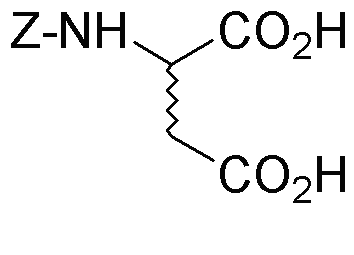Z-DL-aspartic acid is widely utilized in research focused on:
- Pharmaceutical Development: This compound serves as a key building block in the synthesis of various pharmaceuticals, particularly in the development of drugs targeting neurological disorders.
- Food Industry: It is used as a flavor enhancer and nutritional supplement, providing essential amino acids that support human health and well-being.
- Biotechnology: Z-DL-aspartic acid is important in the production of peptides and proteins, facilitating advancements in genetic engineering and therapeutic protein production.
- Agriculture: The compound is applied in formulating fertilizers that enhance plant growth by improving nitrogen utilization, thus promoting sustainable agricultural practices.
- Research and Development: It is commonly used in biochemical studies to explore metabolic pathways and enzyme activities, contributing to a deeper understanding of cellular processes.
General Information
Properties
Safety and Regulations
Applications
Z-DL-aspartic acid is widely utilized in research focused on:
- Pharmaceutical Development: This compound serves as a key building block in the synthesis of various pharmaceuticals, particularly in the development of drugs targeting neurological disorders.
- Food Industry: It is used as a flavor enhancer and nutritional supplement, providing essential amino acids that support human health and well-being.
- Biotechnology: Z-DL-aspartic acid is important in the production of peptides and proteins, facilitating advancements in genetic engineering and therapeutic protein production.
- Agriculture: The compound is applied in formulating fertilizers that enhance plant growth by improving nitrogen utilization, thus promoting sustainable agricultural practices.
- Research and Development: It is commonly used in biochemical studies to explore metabolic pathways and enzyme activities, contributing to a deeper understanding of cellular processes.
Documents
Safety Data Sheets (SDS)
The SDS provides comprehensive safety information on handling, storage, and disposal of the product.
Product Specification (PS)
The PS provides a comprehensive breakdown of the product’s properties, including chemical composition, physical state, purity, and storage requirements. It also details acceptable quality ranges and the product's intended applications.
Certificates of Analysis (COA)
Search for Certificates of Analysis (COA) by entering the products Lot Number. Lot and Batch Numbers can be found on a product’s label following the words ‘Lot’ or ‘Batch’.
*Catalog Number
*Lot Number
Certificates Of Origin (COO)
This COO confirms the country where the product was manufactured, and also details the materials and components used in it and whether it is derived from natural, synthetic, or other specific sources. This certificate may be required for customs, trade, and regulatory compliance.
*Catalog Number
*Lot Number
Safety Data Sheets (SDS)
The SDS provides comprehensive safety information on handling, storage, and disposal of the product.
DownloadProduct Specification (PS)
The PS provides a comprehensive breakdown of the product’s properties, including chemical composition, physical state, purity, and storage requirements. It also details acceptable quality ranges and the product's intended applications.
DownloadCertificates of Analysis (COA)
Search for Certificates of Analysis (COA) by entering the products Lot Number. Lot and Batch Numbers can be found on a product’s label following the words ‘Lot’ or ‘Batch’.
*Catalog Number
*Lot Number
Certificates Of Origin (COO)
This COO confirms the country where the product was manufactured, and also details the materials and components used in it and whether it is derived from natural, synthetic, or other specific sources. This certificate may be required for customs, trade, and regulatory compliance.


